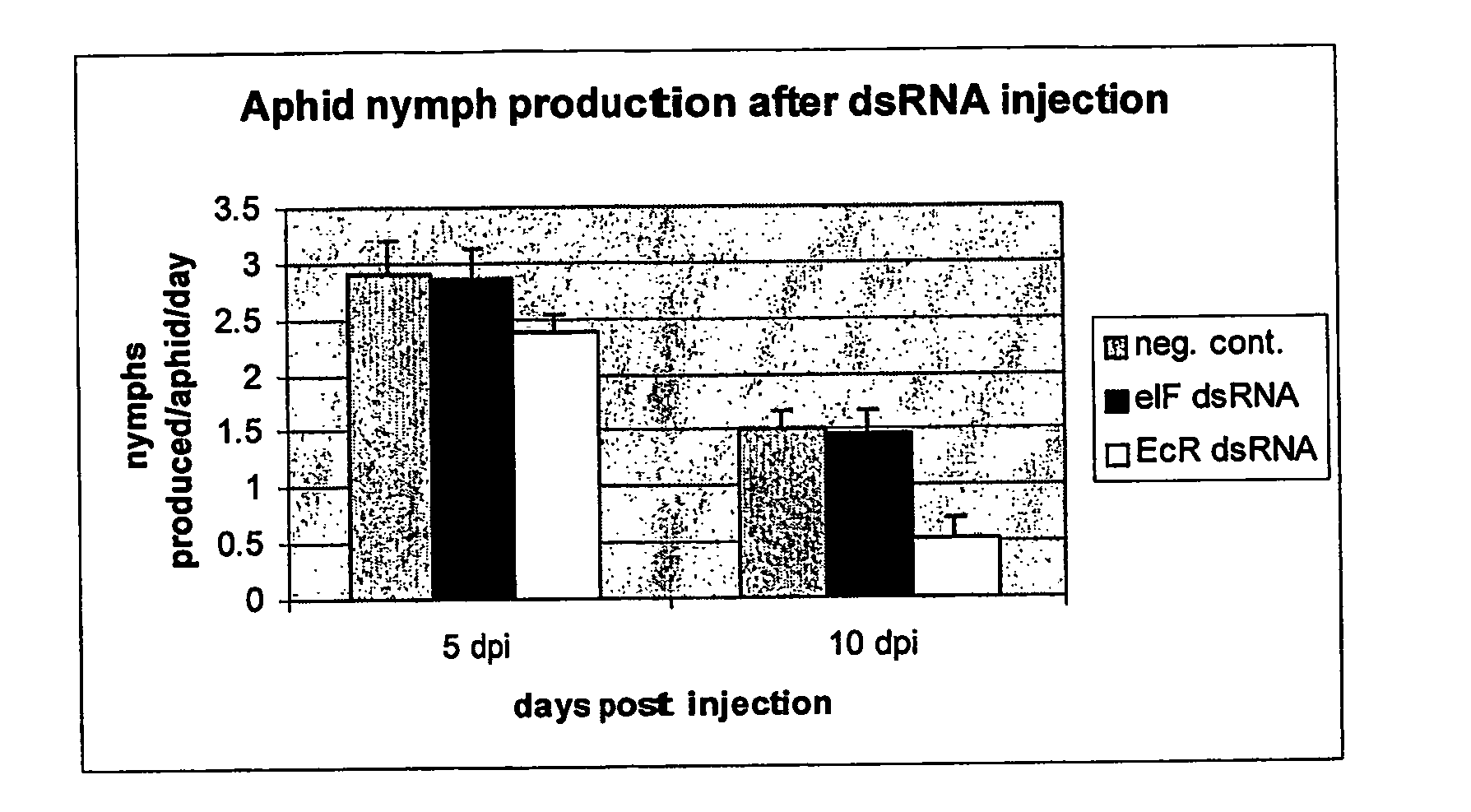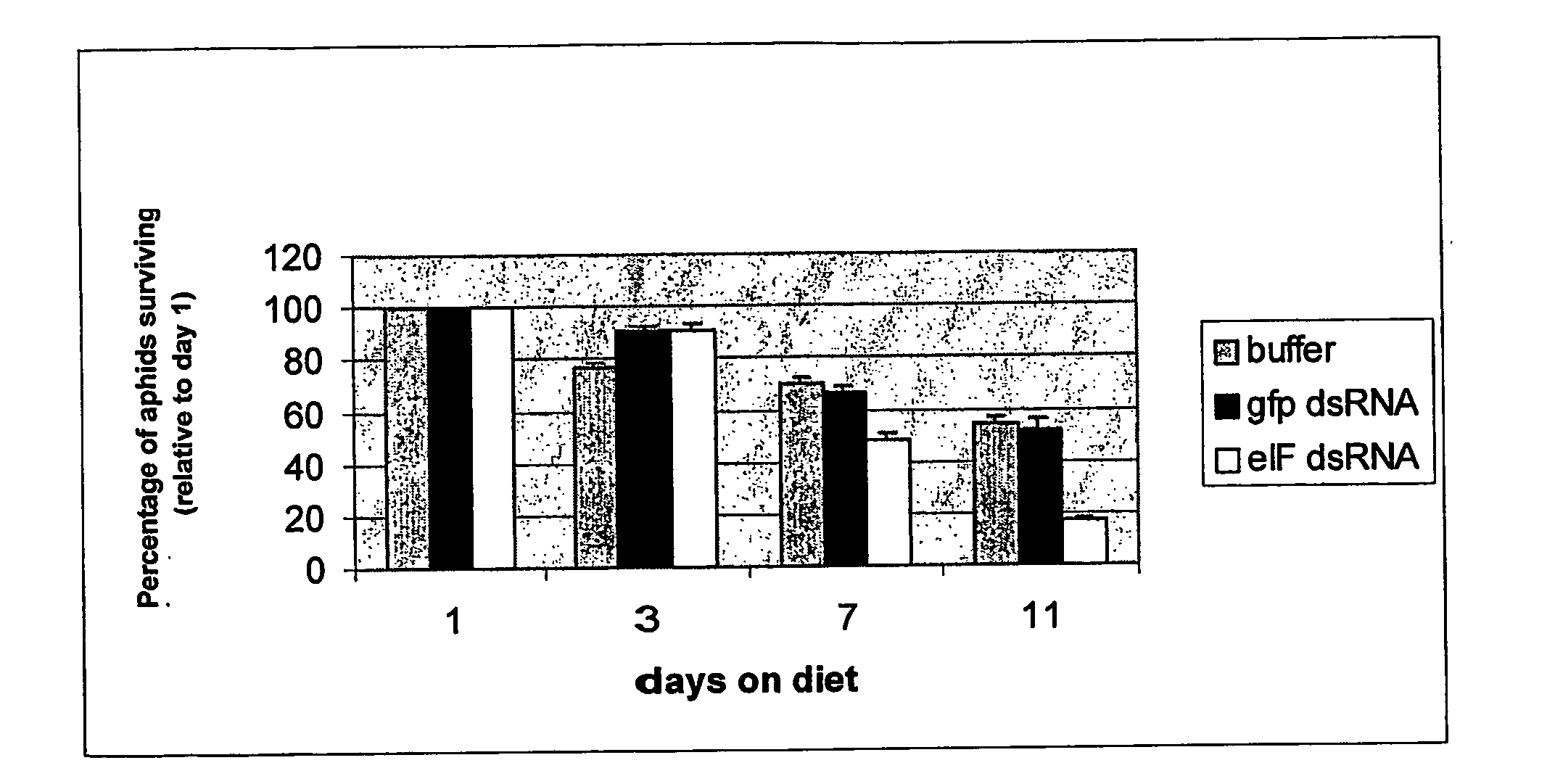Insect resistance using inhibition of gene expression
a technology of insect resistance and gene expression inhibition, which is applied in the direction of plant/algae/fungi/lichens, peptides, plant/algae/fungi/lichens ingredients, etc., can solve the problems of prior art not showing the introduction of dsrna into neonate larvae of i>s. litura /i>, and achieve the effect of suppressing insect genes
- Summary
- Abstract
- Description
- Claims
- Application Information
AI Technical Summary
Problems solved by technology
Method used
Image
Examples
example 1
Injection and Feeding of Aphids with dsRNA Insect Rearing
[0097]Aphis gossypii were raised on 3-5 week old cotton plants, at 25° C. under a 14 hour:10 hour day / night cycle, with low to medium humidity. Between 5 and 10 apterae adults were placed on each plant on a weekly basis. Myzus persicae were raised on 3-5 week old radish plants, at 20° C. under a 14 hour:10 hour day / night cycle with low to medium humidity. Between 10 and 15 apterae adults were placed on each plant every two weeks.
PCR Amplification and Sequence Analysis of Aphid Genes
[0098] Total RNA was extracted from a population of aphids of mixed life stages using a Qiagen RNeasy Minikit™, according to the manufacturer's specifications. The RNA (−250 ng) was used to prepare cDNA using Invitrogen's Thermoscript RT-PCR System™, using oligo(dT) primers. The resulting cDNA was then used as template for the amplification of the eukaryotic initiation factor.
[0099] Degenerate PCR primers were designed to span moderate to highl...
example 2
Analysis of Aphid Feeding on Plants Transiently Expressing dsRNA
[0132] To confirm that plants can deliver dsRNA or siRNA to plant sap-sucking insects such as aphids in planta without transfection promoting agents, aphids are added to tobacco plants transiently induced to produce aphid dsRNA using the SVISS methodology described in published PCT application WO 03 / 052108 (incorporated herein by reference), using dsRNA targeted to a M. persicae essential gene.
[0133] These experiments confirm that the dsRNA transiently produced in plants in an unpackaged form, free from transfection-promoting agents, can result in a significant inhibition of M. persicae development.
example 3
Analysis of Aphid Feeding on Plants Stably Expressing dsRNA in Phloem
[0134] In this experiment, Arabidopsis and tobacco plants are transformed by Agrobacterium-mediated transformation with a vector containing a dsRNA chimeric gene targeting either the M. persicae eIF1A gene, the M. persicae ecdyson receptor (EcR) or the control GFP gene. A M. persicae ecdyson receptor DNA sequence was cloned from this aphid as described above. A plant dsRNA chimeric gene is made wherein either the phloem-specific rolC promoter (Pandolfini et al., 2003) or the constitutive CaMV 35S promoter is operably linked to the dsRNA construct, containing sense and antisense regions to the above target aphid gene or the control gene. Plants are tested for transformation using Southern blot analysis and for expression and dicing of the dsRNA by small RNA Northern blot assay. Transport of interfering RNAs to the phloem is confirmed by the significant reduction in development of Myzus persicae feeding on the succe...
PUM
| Property | Measurement | Unit |
|---|---|---|
| pH | aaaaa | aaaaa |
| inner diameter | aaaaa | aaaaa |
| pH | aaaaa | aaaaa |
Abstract
Description
Claims
Application Information
 Login to View More
Login to View More - R&D
- Intellectual Property
- Life Sciences
- Materials
- Tech Scout
- Unparalleled Data Quality
- Higher Quality Content
- 60% Fewer Hallucinations
Browse by: Latest US Patents, China's latest patents, Technical Efficacy Thesaurus, Application Domain, Technology Topic, Popular Technical Reports.
© 2025 PatSnap. All rights reserved.Legal|Privacy policy|Modern Slavery Act Transparency Statement|Sitemap|About US| Contact US: help@patsnap.com


